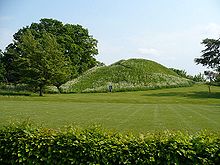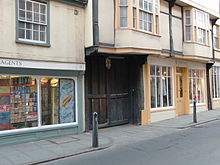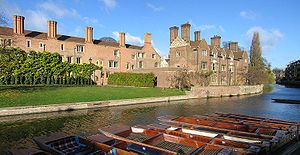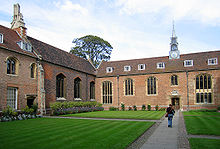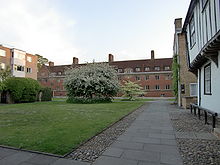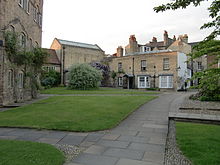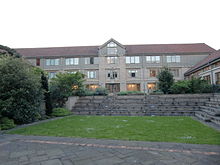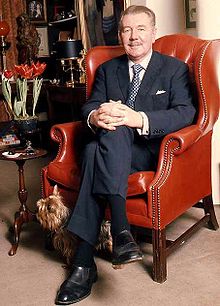- Magdalene College, Cambridge
-
Coordinates: 52°12′37″N 0°6′58″E / 52.21028°N 0.11611°E
Colleges of the University of Cambridge
Magdalene College
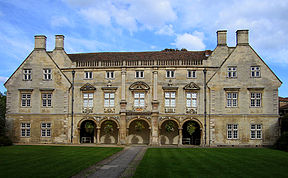
Full name The College of Saint Mary Magdalene Founders John Lytlington, Abbot of Crowland (1428)[1]
Thomas, 1st Baron Audley (1542)[2]Named after Mary Magdalene Established 1428[1]
Refounded 1542[2]Previously named Buckingham College (1428–1542) Admittance Men and women Master Mr Duncan Robinson Undergraduates 339[3] Graduates 240[3] Sister college Magdalen College, Oxford Location Magdalene Street (map) 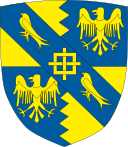
Garde ta Foy
(Old French, "Keep your faith")College website Boat Club website Magdalene College (
 /ˈmɔːdlɪn/ mawd-lin)[4] is a constituent college of the University of Cambridge, England.
/ˈmɔːdlɪn/ mawd-lin)[4] is a constituent college of the University of Cambridge, England.The college was founded in 1428 as a Benedictine hostel, in time coming to be known as Buckingham College, before being refounded in 1542 as the College of St Mary Magdalene. Magdalene College has some of the grandest benefactors including Britain's premier noble the Duke of Norfolk, the Duke of Buckingham and Lord Chief Justice Sir Christopher Wray.[5] However the refoundation was largely the work of Sir Thomas Audley, Lord Chancellor under Henry VIII. Audley also gave the College its motto — garde ta foy (Old French: "keep your faith"). Audley's successors in the Mastership and as benefactors of the College were however prone to dire ends; several benefactors were arraigned at various stages on charges of high treason and executed.[6]
The College's most famous alumnus is Samuel Pepys, whose papers and books were donated to the College upon his death, and are now housed in the Pepys Building. The College boasts a portrait of the famous diarist by Sir Peter Lely, which hangs in the Hall. Magdalene is noted for its 'traditional' style: it boasts a well-regarded candlelit formal hall (held every evening) and was the last all-male College in Oxford or Cambridge to admit women in 1988 (Oriel College was the last in Oxford, admitting women in 1985). This resulted in protests by some undergraduates, including the wearing of black armbands and flying the college flag at half-mast.[6]
Magdalene's old College buildings are representative of the College's ramshackle growth from a monks' foundation into a centre of education. It is also distinctive in that most of the old buildings are in brick rather than stone (save for the frontage of the Pepys Building). Magdalene Street divides the most ancient courts from more recent developments. One of the accommodation blocks in the newer part of the college was built by Sir Edwin Lutyens in the early 1930s.
Magdalene remains, despite this 20th-century expansion, one of the smaller colleges within the University, numbering some 300 undergraduates and an expanding postgraduate community. Opened in 2005 was Cripps Court, on Chesterton Road, featuring new undergraduate rooms and conference facilities.
Contents
History
Buckingham College
Magdalene College was first founded in 1428 as Monk's Hostel, which hosted Benedictine student monks. The secluded location of the hostel was chosen because it was separated from the town centre by the River Cam and protected by the Cambridge Castle. The main buildings of the college were first constructed in the 1470s under the leadership of John de Wisbech, then Abbot of Crowland.[7] Under the patronage of Henry Stafford, 2nd Duke of Buckingham, the institution was renamed Buckingham College.[1]
In the 16th century, the Church of England broke away from the Papacy. With the subsequent Dissolution of the Monasteries, the parent abbey of Buckingham College, Crowland Abbey, was dissolved. However, the college remained in operation.[2]
Refoundation
Walden Abbey, one of the Benedictine abbeys associated with Buckingham College, came into the possession of Thomas Audley after the Dissolution of the Monasteries. In 1542, Audley refounded Buckingham College as the College of Saint Mary Magdalene. Derived from Audley were the arms of Magdalene, including the motto Garde Ta Foy (from Old French for "keep your faith"), and the wyvern as the crest.[2]
Thomas Audley died in 1544 aged 56, only two years after he re-founded the college. He donated to the college seven acres of property at Aldgate in London, which was his reward from Henry VIII for disposing of Anne Boleyn. This property would have brought enormous income had it been retained by the college.[2] However, under the conspiracy of the Elizabethan banker Benedict Spinola, the property was permanently alienated to the Crown in 1574.[8]
The transaction involved Spinola luring the master and fellows of the time to accept an increase in the annual rental from £9 to £15 a year in exchange for the property. The loss of the Aldgate property left the college in extreme poverty, and the street front of the college was only completed in the 1580s under the generosity of Christopher Wray, then Lord Chief Justice of the Queen's Bench. The transaction was "almost certainly illegal", and was contested multiple times without success.[9] The first and most famous lawsuit of such kind was pursued in 1615 by Barnaby Goche, was master of the college between 1604 and 1626. The court case landed Goche and the senior fellow in prison for two years.[10] Goche was subsequently offered £10000 as a compromise, which he refused to accept. When the Quayside development site of Magdalene College was completed in 1989, a gargoyle of Spinola which spits water into the Cam was installed as a "revenge at last".[9]
In 1650, Samuel Pepys joined the college. He was best known for his private diaries, known to critics as the Pepys Diary, which provided a major eyewitness account for the Great Fire of London of 1666.[11][12] Pepys was remembered by the Pepys Library, built around 1700,[13] where the original manuscripts of his diaries and naval records are kept since their donation by the Pepys family to the college in 1703.[14] The building is also home to the Magdalene College library.[14]
Enlightenment
Daniel Waterland, a theologian by training, became master of the college in 1714 and prescribed a new curriculum for undergraduate students at Magdalene.[15] His new curriculum included Mathematics, Newtonian Physics, Geography and Astronomy, as well as Classics, Logic and Metaphysics. Waterland was also successful in attracting financial aid for the college, including funds for scholarships.[16] The mathematician Edward Waring was among those who joined the college during this period.[17]
In 1781, Peter Peckard, one of the earliest abolitionists, became master of Magdalene. The Zong Massacre of 1781 prompted Peckard to speak strongly against slave trade in his sermons, some of which were published as tracts and pamphlets.[18] Peckard set the college on the course of achieving a wider reputation of scholarship and sound thinking, and was appointed as vice-chancellor of Cambridge University later on.[16]
Magdalene College continued to be a liberal college through the Victorian era. The college had more liberal admissions policies than most, admitting Arthur Cohen, the first practising Jew to graduate from Cambridge.[19] During the same period, Magdalene also admitted Catholic students such as Charles Januarius Acton, and Asian students who were excluded from many other colleges until after the First World War.[20]
Modern development
The modern development of Magdalene was shaped by A. C. Benson, master from 1915 to 1925.[21] His enthusiasm and attention to detail produced outstanding pieces of poems, essays and literary criticism; his diaries were also studied by many later critics. His financial generosity effected significant impact on the modern appearance of the college grounds: at least 20 inscriptions around the college refer to him.[22] In 1930, Benson court was constructed and named after A. C. Benson.[13]
From 1972, the previously all-male colleges in Cambridge started admitting women, the first being Clare College and King's College.[23] In 1985, Oriel College, Oxford began admitting women, making Magdalene the only surviving all-male Oxbridge college. Magdalene made the controversial decision in 1986 to admit women and go co-residential.[24] When women eventually joined the college in 1988, male students protested by wearing black arm-bands and flying the college flag at half-mast.[6]
Although the historical perception of Magdalene's bias towards undergraduate applicants from independent schools persisted,[25] Magdalene has now an evenly mixed student body in terms of sex, race and education background.[24] In recent years, Magdalene's access programme has attracted many applicants from state schools, especially from North West England;[26] and the college's close affiliation with international students' bursaries such as the Prince Philip Scholarship and the Jardine Foundation has attracted many applicants from Southeast Asia, most notably Wong Yan Lung who went on to become Secretary for Justice for Hong Kong.[27]
Buildings and grounds
Magdalene College is located at the bend of the River Cam on the northwestern side of the town centre, at the foot of Castle Hill, Cambridge. The college was deliberately built on the opposite side of the river from the town centre so that the Benedictine student-monks would be secluded from the business and temptations of the town.[28] As such, it was the first Cambridge college to be built on the northwestern side of the Cam.[13] The college's main site was previously settled during the Roman occupation of England.[1]
The college's buildings are distributed on both sides of the river, and is roughly divided into four areas: the main site, where the oldest buildings including the porter's lodge and the Pepys Library are located; The Village, built in the 1930s and is exclusively student accommodation; Quayside, built on the southeastern side of the river in the 1980s as an investment project which also provides student accommodation;[29] and Cripps Court, built in the 2000s for extra conference facilities and accommodation.[30]
Main site
The main site of Magdalene College is the area bounded by Magdalene Street, Chesterton Lane and the River Cam. It is the first area to be populated by college buildings since as early as the 1470s.[1] This area includes Magdalene's First Court, Second Court, Fellows' Garden, and the buildings surrounding them such as the porters' lodge, the Master's Lodge, and the famous Pepys Library.[31]
Porter's lodge and First Court
Aptly situated on the north-east side of Magdalene Street, a main street with heavy traffic, the porter's lodge is the first point of call for any English educational institution. It is the place where mail to members of the college is delivered and distributed. Passing the gatehouse by which the porter's lodge is situated, the First Court is immediately reached.[31] The First Court, as its name suggests, was the earliest court to be built. Most of the buildings have been rebuilt in the restoration project which happened between 1953 and 1966. As a result, the court still looked the same as it was first built between 1470 and 1585, but few parts of the original buildings survived.[32] The porter's lodge was not the first to be constructed: the gatehouse including the porter's lodge and the street-front of the college did not exist until 1585. Instead, the chapel was the first to be built around 1470.[29]
The chapel lies to the north range of First Court, and its original construction dates to 1470-72. However, later renovation works meant that little of the original chapel other than the original roof remains. Since the college is dedicated to Mary Magdalene, much of the chapel's artwork describes her story. The glass windows on the eastern wall of the chapel are entirely dedicated to the encounters between Mary Magdalene and Jesus Christ around the time of the crucifixion of Jesus: anointing Jesus with her jug of ointment, watching the crucifixion, weeping at the tomb and recognising Jesus after his resurrection. Compared to most other Cambridge colleges of medieval origin, Magdalene College's chapel is much smaller and cosier, in line with the college's relatively small population.[33]
Past the chapel, the formal hall separates the First Court to the west and the Second Court to the east. It is the place where daily formals happen. The hall itself was first built in the early 16th century, again with many later refurbishments. To the far end is the High Table, placed on a platform a step above ground level, where fellows and their guests dine; in front of it are three long benches, perpendicular to the High Table, that span to the entrance, where students dine. Hung on the walls are 15 portraits of Magdalene's benefactors and notable past members.[29]
Both the old and new Master's Lodges are located just to the north of first court. The old Master's Lodge, connected directly to the building on which the porter's lodge was situated, was built in the 16th century and vacated in 1835. The Master's Lodge then moved to a new location about 50m north of te previous location;[31] this new lodge was subsequently torn down and rebuilt in 1967 to give the Master a less grandiose, but more comfortable residence. The building which used to be Master's Lodge is now known as Old Lodge, and is predominantly student accommodation.[29] Other than Old Lodge, there are also student rooms scattered around the buildings surrounding First Court, including the areas on top of the formal hall.[31]
Second Court and gardens
Past the formal hall, the Second Court is most clearly marked by the Pepys Building, where the Pepys Library is housed. The architect and polymath Robert Hooke, otherwise best known for coining the idea of a biological cell, participated in designing this building in 1677, and construction carried on from then until the 1700s because of the college's lack of money.[29] The inscription on the arch in front of the building, Bibliotheca Pepysiana 1724, refers to the year in which the Pepys Diary was donated to the college, rather than the year in which the building was completed.[34] Because of the famous Pepys Diary, the Pepys Library became a popular tourist destination in Cambridge.[6] The ground and basement levels of the Pepys Building host the college library, where undergraduates course books are available and is therefore a major study spot for undergraduates.[29]
Also situated on Second Court is Bright's Building, named after Mynors Bright, who was most famous for having deciphered the Pepys Diary. It was built in 1908-09 by Aston Webb to provide extra accommodation to host increasing numbers of undergraduate students.[13] The largest room in Bright's Building is Ramsay Hall, named after Allen Beville Ramsay. The room was originally intended to be a lecture room, but it was later refurbished in 1949 to become the college's canteen.[29] The Pepys Building was also constructed in a way that it would provide a good view of the Fellows' Garden with all the trees and flowers planted in it.[35]
The Fellows' Garden, situated behind Pepys Building, included a Roman-era flood barrier bank which became today's Monk's Walk, a raised footpath leading from the south side of Pepys Building to the exit of Fellows' Garden on Chesterton Lane. At the time of the college's establishment in 1428, the Fellow's Garden was a series of fishponds. The fishponds were filled between 1586 and 1609, but it was only until the 1660s that plans to cultivate a garden on the land were realised. Most of the trees planted in the original plan of the garden were chopped and replaced in a renovation in the early 1900s, under the instruction of botanist Walter Gardiner. Most of the trees in the Fellows' Garden became black poplars and its variant, Lombardy poplars. Some fruit trees, such as quince, cherry and plum trees, were later planted in the 1980s-90s. Squirrels, and the occasional woodpecker may be spotted in the garden; there are also a few flowerbeds in the garden on which the gardeners grow seasonal flowers.[35]
Adjacent to the Fellows' Garden are two other gardens: the Master's Garden, which is part of the Master's Lodge and separated from the Fellows' Garden by a brick wall;[29] and the River Court, a small, brick-paved patch of land between Bright's Building and the River Cam, where seasonal flowers are on display in the flowerbeds.[34]
The Village
The area of Magdalene College across Magdalene Street from porter's lodge, bounded by Magdalene Street, Northampton Street, the River Cam and St John's College is known as the Magdalene Village.[3] It includes Benson Court, Mallory Court and Buckingham Court, and consists almost exclusively of student accommodation.[34] The whole area of the Village was gradually developed over a period of 45 years by three different architects, Harry Redfern, Edwin Lutyens and David Roberts. The first building developed was Mallory Court B (1925–26) and the last was the new Buckingham building (1968–70). Edwin Lutyens had an original plan which involved demolishing many existing building in the area and constructing new buildings that matched the general look and feel of the college's main site; however this plan was scrapped due to insufficient funding, and the only part of Lutyens's plan that was realised was the Lutyens building.[29]
Passing through an obscure wooden gate opposite the porter's lodge, the open courtyard of Benson Court can be seen. Benson Court was named after A. C. Benson, master of Magdalene college from 1915 to 1925. Benson was best known for writing the lyrics of Land of Hope and Glory, a British patriotic song set to the tune of Edward Elgar's Pomp and Circumstance March No. 1.[34] The cottages to either side of the entrance pathway are all pre-existing buildings that were converted into student accommodation in the 1960s. In particular, Benson Court H is one of the few buildings in college which structure survived from the 16th century, and presents its 17th-century facade which was previously known as Cross Keys Inn to the street front of Magdalene Street.[29] To the left of the courtyard is a gentle grassy slope that leads to the "Magdalene beach", where the college punts are moored and parties are held in the summer.[36]
Across the courtyard is the Lutyens building, also designated Benson A-E, which was built and named after Edwin Lutyens, the architect who planned much of the Village. Due to a lack of funding, it was the only part of Lutyens's original grandiose plan that was actually built. Part of the building's cost was sponsored by subscriptions raised by Harvard in memory of Henry Dunster, who studied in Magdalene in 1627-30 and later became a founding father of Harvard University. Hence, the crest of Harvard with the inscription Veritas was found at the entrance to the D staircase.[29] Each staircase in the building had slightly different banister designs, which Lutyens explained was "to help Magdalene men to feel in the dark whether they were entering the correct staircase".[37] The Lutyens building currently hosts about 60 students and fellows, and the college launderette.[38]
Another two courts can be found to the northwest of Benson Court: Mallory Court and Buckingham Court. Mallory Court was named after George Mallory, the British mountaineer who famously answered "Because it was there" when asked why he wanted to climb Mount Everest.[39] The court itself comprises student rooms, some new and some converted from existing buildings which included a defunct brewery. Buckingham Court has two groups of buildings, which included the "Tan Yard Cottages" incorporated to the college and refurbished in 1966, and a new building which contained the college's car park. Completed in 1970, the new Buckingham building marked the completion of the entire Magdalene Village.[29]
Quayside
Most of the buildings bounded by the River Cam, Bridge Street and Thompson's Lane are owned by Magdalene College, despite being completely covered by shop-fronts and restaurants on the ground level. Many of these buildings are part of the Quayside development project, built between 1983–89, as part of a business plan of the college. As for student accommodation, this part of the college includes the Bridge Street hostels, and the Thompson's Lane hostels.[40]
Cripps Court
Situated on the opposite side of Chesterton Lane from the main site of the college, Cripps Court is the newest part of Magdalene. It was built between 2003-05 in response to increasing demands for extra accommodation and conference facilities. The site of Cripps Court is a natural southerly slope, which can be seen from the stepped courtyard in between the buildings.[41] The court was sponsored by, and named after, the Cripps family headed by Humphrey Cripps. It contains a 142-seat auditorium,[42] 5 seminar rooms, an oak-roofed event gallery also called the orangery, and about 60 student rooms.[43]
Events and traditions
Spelling and pronunciation of name
Magdalene College is officially known as "The College of Saint Mary Magdalene", with "Magdalene" customarily pronounced "Maudlyn" (/ˈmɔːdlɨn/ mawd-lin). The name was chosen when Thomas Audley re-founded the college in 1542 and dedicated the college to Mary Magdalene. In early documents, the name of the college was spelt "Maudleyn" as it was pronounced, which contained the name "Audley" in the spelling. Although the standard pronunciation of the name "Magdalene" in the English language has changed, the customary pronunciation of the college's name was retained.[4]
With the development of the General Post Office during the 19th century, the spelling of the college's name was fixed as "Magdalene". The final "e" in the name was introduced to avoid confusion with Magdalen College, Oxford.[4]
College grace
Benedic Domine nobis et donis tuis quae de tua largitate sumus sumpturi, et concede ut illis salubriter nutriti tibi debitum obsequium praestare valeamus, per Jesum Christum Dominum et Servatorem Nostrum, Amen.
Bless us Lord and your gifts, which from your bounty we are about to receive, and grant that we, healthfully sustained by them, may render to you our dutiful service, through Jesus Christ, our Lord and Saviour, Amen.
May Ball
The College's famous May Ball had been a biennial fixture since 1911. Magdalene May Ball is known as the most lavish and prestigious Ball in Cambridge for several reasons: it is the only remaining Cambridge ball to always insist on white tie dress code and it is the only ball in Cambridge to sell a majority of dining tickets over non-dining.[44][45]
People
Master
The "Master of Magdalene College" is the name given to the Head of House. The post has been held by Duncan Robinson since 2002.
Under the College Statutes, the Master is appointed by the Visitor of the College and usually serves until reaching the statutory fellowship retirement age of 67. Exceptionally, this period may be extended until the Master in question reaches 70. This has occurred in the case of the current Master.
With the position of Master comes College-based residency in the form of the Master's Lodge, which may be populated and decorated according to the wishes of the Master. Traditionally, every Sunday, the Master attends the service in the College Chapel before sitting at the head of the High Table in Hall for the evening meal.
Notable current fellows
- Professor Nicholas Boyle (Schroeder Professor of German and biographer of Goethe)
- Professor Helen Cooper (literary scholar) (Professor of Medieval and Renaissance English, Cambridge University, a Chair formerly held by three previous Magdalene fellows: C.S. Lewis, J.A.W. Bennett and John Stevens)
- Professor Eamon Duffy (Professor of the History of Christianity and well known Roman Catholic commentator)
- Professor Sir John Gurdon (former Master, honorary fellow, developmental biologist, begetter of the Gurdon Institute)
- Professor Emma Rothschild (Jeremy and Jane Knowles Professor of History at Harvard University, director of the Centre for History and Economics)
Notable alumni
See also: Category: Alumni of Magdalene College, Cambridge- Simon Ambrose (Winner of The Apprentice (UK series three))
- Giles Baring (cricketer)
- Rt. Revd. Simon Barrington-Ward (Bishop of Coventry, 1985–1997)
- Henry Bellingham (Member of Parliament for North West Norfolk, junior minister at the Foreign and Commonwealth Office)
- A. C. Benson (librettist of Land of Hope and Glory)
- Patrick Blackett (Nobel Prize winning physicist)
- Sir John Boardman (archaeologist, Professor of Classical Art and Archaeology)
- Charles Vyner Brooke (last White Rajah of Sarawak)
- Anthony Bull (transport engineer)
- David Burghley (Olympic champion, 400m hurdles)
- Sir David Calcutt (former Master and barrister)
- Henry Chadwick KBE (former head of Christ Church, Oxford)
- Greg Clark (Member of Parliament for Tunbridge Wells, Minister of State in the Department for Communities and Local Government)
- David Clary (President, Magdalen College, Oxford)
- Arthur Cohen (lawyer and Liberal politician; first Jewish graduate of Cambridge University)
- Peter Cowie (film historian)
- Thomas Cranmer (Archbishop of Canterbury and graduate of Jesus College; Fellow of Magdalene)
- Stella Creasy (Member of Parliament for Walthamstow)
- Katie Derham (TV newsreader)
- Monty Don (gardener)
- William Donaldson (creator of Henry Root)
- Henry Dunster (first President of Harvard University)
- Julian Fellowes (actor and Academy Award winning screenwriter)
- Bamber Gascoigne (TV presenter, University Challenge)
- Robin Gibson (former Chief Curator, National Portrait Gallery, art historian & writer)
- H.R.H. The Duke of Gloucester (member of the British Royal Family)
- H.R.H. Prince William of Gloucester (member of the British Royal Family)
- Dr Maurice Goldhaber (American physicist)
- Sir Christopher Greenwood QC (British judge)
- Antony Grey (pioneer gay rights activist)
- Sir Norman Hartnell (couturier and dressmaker to the Queen)
- Abdul Khalek Hassouna, Egyptian politician and diplomat, Secretary-General of the Arab League
- Gavin Hastings OBE (rugby international)
- Nick Herbert (Member of Parliament for Arundel and South Downs, Minister of State for Justice)
- Adam Holloway (Member of Parliament for Gravesham)
- Sir Antony Jay (author, Yes Minister)
- Igor Judge, Baron Judge (Lord Chief Justice of England and Wales)
- Dr Akhtar Hameed Khan (Social scientist)
- Charles Kingsley (author of The Water Babies and Regius Professor of Modern History)
- Lewis H. Lapham (American writer)
- Sir Trafford Leigh-Mallory (air vice marshal, Battle of Britain)
- C.S. Lewis (literary critic, author and theologian)
- Chris Lintott (Astrophysicist)
- Selwyn Lloyd (former Foreign Secretary, Chancellor of the Exchequer and Speaker of the House of Commons)
- John McPhee (Pulitzer Prize-winning writer)
- George Mark Malloch Brown, Baron Malloch-Brown (former United Nations Deputy Secretary-General and Minister of State at the Foreign and Commonwealth Office)
- George Mallory (mountaineer)
- John Manningham (sixteenth- and seventeenth-century diarist, lawyer; noted for recording details of an original performance of Shakespeare's Twelfth Night)
- Kingsley Martin (journalist)
- Sir Samuel Morland (diplomat, spy, inventor, mathematician)
- Michael Morris, 3rd Baron Killanin (former President of the International Olympic Committee)
- Dr Roger Morris (electrical engineer)
- Sir Andrew Morritt (Chancellor of the High Court of Justice)
- Ronald Muwenda Mutebi II (current King or Kabaka of Buganda)
- Sir Edward Frederick Mutesa II (former King or Kabaka of Buganda and President of Uganda)
- Mike Newell (film director whose works include Four Weddings and a Funeral and Harry Potter and the Goblet of Fire)
- Adam Nicolson (historian and author, son of Nigel Nicolson, and grandson of Vita Sackville-West and Harold Nicolson)
- Charles Stewart Parnell (Irish nationalist, did not graduate)
- Samuel Pepys (naval administrator, MP and diarist)
- Francis Pym (former Secretary of State for Foreign and Commonwealth Affairs)
- Michael Ramsey (Archbishop of Canterbury)
- Julian Rathbone (English novelist)
- Sir Michael Redgrave (actor)
- Alan Rusbridger (editor, The Guardian)
- Sir Frederic Salusbury (Editor of the Daily Herald)
- Nicholas Shakespeare (novelist)
- John Simpson (journalist)
- Arthur Tedder, 1st Baron Tedder (Marshal of the Royal Air Force, World War II)
- John Tedder, 2nd Baron Tedder (Professor of Chemistry, expert in free radical chemistry)
- Ven. Nanavira Thera (Buddhist monk)
- Philip Vellacott (Classical scholar)
- Roger Vignoles (concert pianist and accompanist)
- Rob Wainwright (rugby international)
- Wong Yan-lung (Secretary for Justice of Hong Kong)
- Geoffrey Webb (art historian)
- Geoffrey Whitney (sixteenth-century poet and emblematist)
Notable Honorary Fellows
See also: Category:Fellows of Magdalene College, CambridgeReferences
- ^ a b c d e "College History, The Early Days". Madgalene College website. http://www.magd.cam.ac.uk/about/history/early-days.html. Retrieved March 8, 2009.
- ^ a b c d e "College History, Tudor Times". Madgalene College website. http://www.magd.cam.ac.uk/about/history/tudor-times.html. Retrieved March 8, 2009.
- ^ a b c "Undergraduate Admissions: Magdalene College". University of Cambridge website. http://www.cam.ac.uk/admissions/undergraduate/colleges/magdalene/. Retrieved 2011-10-08.
- ^ a b c Why "Maudlyn"? - Magdalene College website. Retrieved March 28, 2010
- ^ "Magdalene College, Cambridge". Cambridge Online. http://www.cambridgeonline.co.uk/articles/Magdalene_College/. Retrieved 2011-01-17.
- ^ a b c d Else, David; Berry, Oliver (2005). Great Britain. Lonely Planet. p. 454. ISBN 1-74059-921-7. http://books.google.com/books?id=u-4_Vjo7ztEC&pg=PA454&lpg=PA454#v=onepage&q=&f=false.
- ^ Page, William, ed. (1906), "Houses of Benedictine monks: The abbey of Crowland", A History of the County of Lincoln: Volume 2, British History Online, pp. 105–18, http://www.british-history.ac.uk/report.aspx?compid=37992, retrieved 2008-11-27
- ^ Oxford's and Worcester's Men And the "Boar's Head" by Gwynneth Bowen, 1973. Retrieved March 29, 2010.
- ^ a b High Finance and Low Cunning - Magdalene College website. Retrieved March 29, 2010.
- ^ Case of the Master and Fellows of Magdalene College - The Oxford Authorship Site. Retrieved March 29, 2010.
- ^ Trease, Geoffrey (1972). Samuel Pepys and his world. Norwich, Great Britain: Jorrold and Son.
- ^ Knighton, C.S. (2004). Pepys, Samuel (1633–1703). Oxford Dictionary of National Biography. Oxford University Press.
- ^ a b c d The colleges and halls - Magdalene - British History Online. Retrieved March 30, 2010.
- ^ a b "The Pepys Library". Magdalene College website. http://www.magd.cam.ac.uk/pepys/collection.html. Retrieved 2010-06-10.
- ^ Waterland, Daniel in Venn, J. & J. A., Alumni Cantabrigienses, Cambridge University Press, 10 vols, 1922–1958.
- ^ a b Eighteenth-century: Enlightenment - Magdalene College website. Retrieved on March 29, 2010.
- ^ Magdalene College, Cambridge in Venn, J. & J. A., Alumni Cantabrigienses, Cambridge University Press, 10 vols, 1922–1958.
- ^ Peter Peckard: Biography and bibliography - Brycchan Carey 2002. Retrieved on March 29, 2010.
- ^ Cohen, Arthur in Venn, J. & J. A., Alumni Cantabrigienses, Cambridge University Press, 10 vols, 1922–1958.
- ^ Victorian Magdalene - Magdalene College website. Retrieved March 30, 2010.
- ^ Benson, Arthur Christopher in Venn, J. & J. A., Alumni Cantabrigienses, Cambridge University Press, 10 vols, 1922–1958.
- ^ Twentieth Century - Magdalene College website. Retrieved March 30, 2010.
- ^ O'Grady, Jane (2003-06-13). "Obituary - Professor Sir Bernard Williams". London: The Guardian. http://www.guardian.co.uk/obituaries/story/0,3604,976477,00.html. Retrieved 2009-05-08.
- ^ a b "Magdalene in the Twenty-First Century". Magdalene College website. http://www.magd.cam.ac.uk/about/history/twenty-first.html. Retrieved March 30, 2010.
- ^ "Does university elitism still exist?". BBC News. November 4, 2001. http://news.bbc.co.uk/2/hi/talking_point/1630031.stm. Retrieved March 31, 2010.
- ^ Alternative Prospectus. Magdalene College JCR. 2009.
- ^ "Wong Yan Lung". GovHK. http://www.gov.hk/en/about/govdirectory/po/sj.htm. Retrieved 2010-05-13.
- ^ Cunich, Peter; Hoyle, David; Duffy, Eamon; and Hyam, Ronald (1994). A History of Magdalene College Cambridge, 1428–1988. Cambridge: Magdalene College Publications. ISBN 0-9523073-0-8.
- ^ a b c d e f g h i j k l Hyam, R. (1982). Magdalene Described. Sawston, Cambridgeshire, U.K.: Crampton & Sons Ltd.
- ^ "Magdalene College: Chesterton Road: Cripps Court". Cambridge 2000. http://www.cambridge2000.com/cambridge2000/html/addendum/PA0217412.html. Retrieved 2011-01-18.
- ^ a b c d Magdalene College (2009). College Layout (Map). http://www.magd.cam.ac.uk/about/layout.html.
- ^ "First Court Restoration". Magdalene College. http://www.magd.cam.ac.uk/about/history/1st_crt.html. Retrieved 2011-01-18.
- ^ The Chapel. Cambridge: Magdalene College. 2010.
- ^ a b c d Magdalene College - A Brief Tour Guide. Cambridge: Magdalene College. 2010.
- ^ a b Licence, Tom (2010). A history of the Fellows' Garden, Magdalene College. Cambridge: Magdalene College.
- ^ Hartley, Paul (2010-06-27), "Review of the Year", President's Perspective (Cambridge: Magdalene College JCR)
- ^ Butler, A. S. G. (1950). The architecture of Sir Edwin Lutyens. II. p. 50.
- ^ Undergraduate Students Handbook. Cambridge: Magdalene College. 2009.
- ^ "Climbing Mount Everest is work for supermen". New York Times.
- ^ "Quayside". Cambridge 2000. http://www.cambridge2000.com/cambridge2000/html/0004/P4060546.html. Retrieved 2011-02-15.
- ^ "Magdalene College:Chesterton Road:Cripps Court". Cambridge 2000. http://www.cambridge2000.com/cambridge2000/html/addendum/PA0217412.html. Retrieved 2011-02-15.
- ^ "The Sir Humphrey Cripps Theatre". Cambridge: Magdalene College. http://www.magd.cam.ac.uk/conferences/auditorium.html. Retrieved 2011-02-15.
- ^ "Conferences - Meeting Rooms". Cambridge: Magdalene College. http://www.magd.cam.ac.uk/conferences/rooms.html. Retrieved 2011-02-15.
- ^ "May Week". Varsity. 2007-03-02. http://www.varsity.co.uk/features/332. Retrieved 2011-02-17.
- ^ "UPDATE: May Ball Guide". The Tab. 2011-02-05. http://cambridgetab.co.uk/features/may-ball-guide. Retrieved 2011-02-17.
- ^ Magdalene College. Open Day Prospectus. University of Cambridge. 2008. p. 10.
External links
- Magdalene College website
- Magdalene College Alumni & Development website
- Magdalene College Chapel Choir website
- Magdalene May Ball website
- Magdalene Boatclub
- JCR (undergraduate) Website
- MCR (graduate) Website
- Graduate Union Alternative Prospectus entry for Magdalene
University of Cambridge 
Chancellor: The Lord Sainsbury of Turville (list) · Vice-Chancellor: Sir Leszek Borysiewicz (list)
Colleges: Christ’s • Churchill • Clare • Clare Hall • Corpus Christi • Darwin • Downing • Emmanuel • Fitzwilliam • Girton • Gonville and Caius • Homerton • Hughes Hall • Jesus • King’s • Lucy Cavendish • Magdalene • Murray Edwards (New Hall) • Newnham • Pembroke • Peterhouse • Queens’ • Robinson • St Catharine’s • St Edmund’s • St John’s • Selwyn • Sidney Sussex • Trinity • Trinity Hall • Wolfson
Categories: University • Chancellors • Vice-Chancellors • Colleges • Heads of Colleges • Departments • Academics • Alumni • Awards and Prizes
Websites: University • Students’ Union • Graduate Union
 Categories:
Categories:- Colleges of the University of Cambridge
- Magdalene College, Cambridge
- 1428 establishments in England
- Grade I listed buildings in Cambridgeshire
- Grade I listed educational buildings
- Organisations based in Cambridge with royal patronage
- Mary Magdalene
- Educational institutions established in the 15th century
Wikimedia Foundation. 2010.

